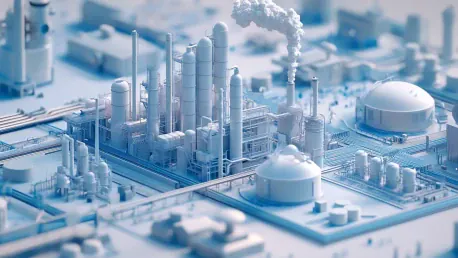In Texas, the booming hydrogen industry signals a transformative journey toward renewable energy and a low-carbon future. However, the burgeoning demand for hydrogen brings substantial water requirements, particularly in water-scarce regions like the Gulf Coast. This article explores the intricate dynamics of hydrogen production’s water needs and investigates strategies for sustainable management.
Rising Hydrogen Demand
The Gulf Coast region is forecasted to need 44.3 million metric tons of hydrogen by 2050 within a net-zero emissions context. This anticipated surge underscores the pivotal role hydrogen will play in Texas’s energy landscape. Yet, with this growing demand comes a critical dependency on water resources.
As the hydrogen demand continues to rise, the importance of water as a crucial component in hydrogen production cannot be overstated. Hydrogen is emerging as a key player in the renewable energy sector, promising a cleaner future but also presenting significant challenges, particularly regarding its water consumption. The processes involved in hydrogen production, whether from renewable or non-renewable sources, each carry specific requirements for water input, making efficient resource management vital.
Understanding Water Needs
Production Methods
Hydrogen can be produced using various methods, each with distinct water consumption profiles. Green hydrogen, generated via water electrolysis powered by renewable energy, demands ultrapure water. On the other hand, blue hydrogen, derived from natural gas reforming, has initial lesser water purity requirements but entails significant purification post-production.
Green hydrogen production involves splitting water molecules into hydrogen and oxygen using electricity derived from renewable sources like wind or solar power. This method is considered environmentally friendly but necessitates high volumes of purified water, presenting a challenge in areas with limited or contaminated water supplies. Blue hydrogen, while still highly dependent on water, uses natural gas as a feedstock through a process known as steam methane reforming (SMR), producing hydrogen and carbon dioxide. The carbon dioxide must then be captured and stored, requiring additional water and energy, thus influencing the overall sustainability of this production method.
Water Demand Projections
By 2050, hydrogen production in Texas might account for 2-6.8% of the state’s total water demand. Although a modest fraction compared to other major water uses like irrigation, the hydrogen sector’s water needs could impose significant local stress, particularly in already vulnerable regions such as the Gulf Coast.
This projected increase highlights the necessity for strategic planning to balance regional resource demands. Even though the overall percentage may seem small on a state level, localized impacts in water-scarce areas can be far more severe. The increased water demand foreseen for hydrogen production, especially when considered alongside other industrial, agricultural, and municipal needs, underscores the importance of integrated and forward-thinking water management policies.
Regional Implications
Gulf Coast Focus
The Gulf Coast is a strategic hub for hydrogen infrastructure and future developments. However, this area is projected to face severe freshwater shortages by 2040, creating a complex scenario for water resource management.
Hydrogen facilities concentrated in the Gulf Coast will benefit from existing infrastructure and proximity to both renewable resources and industrial consumers. However, the anticipated freshwater shortages put significant pressure on local planners to consider alternative water sources or improved recycling techniques. Ensuring sufficient water supply for hydrogen production without compromising the needs of other sectors becomes a delicate balancing act, requiring innovative solutions and collaboration across stakeholders.
Localized Impacts
Even with overall modest state-level water use, the localized impact in regions like the Gulf Coast could be profound. Efficient site selection and integrated planning are essential to mitigate potential water scarcity exacerbations.
Localized impacts are not solely about the volume of water used by hydrogen production but also the timing and availability of these resources. Seasonal variations, climate change, and competing industrial demands can all influence water availability in such regions. Therefore, hydrogen producers and policymakers must take a holistic approach, looking at long-term trends and regional water cycles to develop sustainable water management practices that support both the hydrogen industry and local communities.
Integrated Planning for Sustainability
Balancing Water and Energy Needs
Effective water and energy planning policies are crucial, considering the hydrogen industry’s integrated resource demands. An approach that encompasses the water needs of hydrogen production alongside broader energy goals is necessary for sustainable growth.
Balancing these needs involves understanding the comprehensive lifecycle of water and energy inputs and outputs. Integrated planning must account for the varying demands from the onset of green and blue hydrogen production to their end uses and potential recycling opportunities. By aligning water usage with renewable energy targets, policymakers can create a framework that supports the hydrogen industry’s growth while preserving crucial water resources.
Policy and Technology
Policymakers and industry leaders must support advanced research in water recycling technologies. Innovations could enhance water efficiency in hydrogen production, balancing the trade-offs between blue and green hydrogen methods.
Investment in cutting-edge water treatment and recycling technologies can significantly mitigate the hydrogen industry’s water footprint. These advancements allow for the reuse of process water, reducing the demand on freshwater sources and alleviating pressure on regions prone to water scarcity. Collaborations between academia, industry experts, and government entities are vital to ensure the development and implementation of these technologies, fostering a sustainable hydrogen economy.
Technological and Strategic Approaches
Innovations in Water Recycling
Green hydrogen’s water can be potentially reused after minimal treatment, presenting a sustainable pathway. Investing in water recycling technologies could dramatically reduce the net water footprint of hydrogen production facilities.
The advancements in recycling water used in hydrogen production offer promising avenues for reducing overall water consumption. Technologies that enable the purification and reuse of water not only cut down on the need for fresh water inputs but also contribute to lower operational costs. These practices are especially beneficial in water-scarce regions, making hydrogen production more viable and sustainable while safeguarding essential water resources.
Strategic Project Locations
Choosing strategic project locations plays a critical role in addressing the water needs of the hydrogen industry. By selecting sites with ample water resources or existing infrastructure for recycling and reusing water, the industry can mitigate the impact on water-scarce regions.
Balancing the promise of hydrogen as a clean energy source with the realities of water scarcity and resource management is critical for ensuring the long-term success and sustainability of this burgeoning industry.









